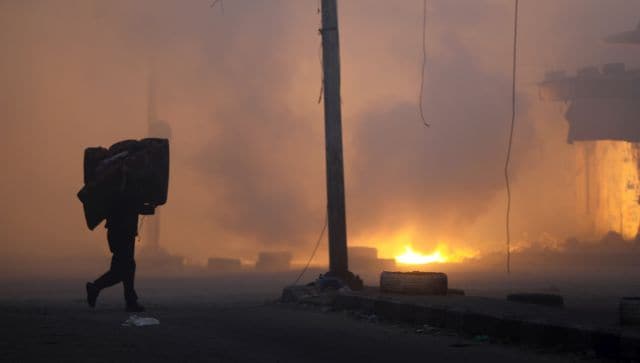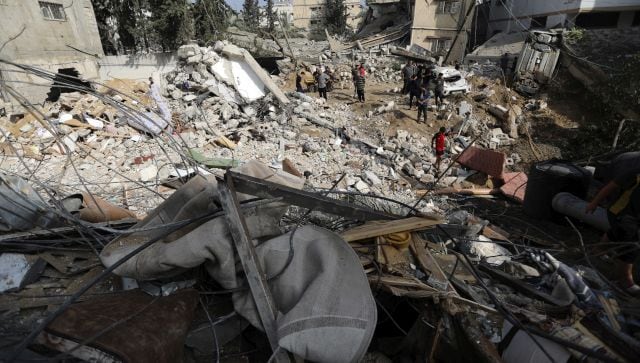There is no stopping Israel. It has intensified its ground campaign and airstrikes on the Hamas-controlled Gaza Strip, bombarding residential areas and forcing thousands of Palestinians to flee the northern part of the territory. On Thursday, Israel said that its troops have “entered” the heart of the enclave . The Israeli military and Hamas operatives are reportedly fighting at close range in Gaza City. Amid this, Gazans are heading south, travelling on foot, to avoid getting trapped between the two warring sides. They are women, children, the elderly and the disabled and they are scared to death. Also read: Can Israel permanently dismantle Hamas? Why Gazans are waving white flags Videos posted online show scores of Gazans walking hurriedly in the backdrop of damaged buildings. The civilians were given a four-hour window to move to the south for safety.
🚨For the 4th day in a row, the @IDF opened an evacuation corridor for civilians in northern Gaza to move southwards. Since 10:00 am today, thousands of Gazans passed through.
— COGAT (@cogatonline) November 8, 2023
The corridor will be open until 14:00 so that Gazans in the north can evacuate for their safety. pic.twitter.com/VTin4VduPW
Some were seen carrying luggage, others were waving white flags and holding identification papers. They can only hope that they are not shot at while trying to escape. Wedad Al-Ghoul, a Palestinian woman, walked eight to nine kilometres from her home on Gaza’s coast along with her son. “I am carrying my ID because I was told it (the passage) will be safe, I don’t know if I am going to be allowed to enter or arrive to the south,” was quoted as saying by CNN. “It was so scary,” said Ola al-Ghul, one of the thousands of Gazan civilians displaced by the month-old war between Israel and Hamas. “We held our hands up and we kept walking. There were so many of us, we were holding white flags,” she told AFP. Clutching one of her toddlers, Amira al-Sakani recalled Israel’s repeated air drops of flyers telling civilians to flee to the south. “We want peace, enough is enough, we are tired, we want a happy future,” she said. The white flags say a lot, but for now, peace is elusive. [caption id=“attachment_13368542” align=“alignnone” width=“640”] A woman holds up a white shirt trying to prevent being shot, as Palestinians flee Gaza City to the southern Gaza Strip on Salah al-Din street in Bureij. AP[/caption] How white flags became synonymous with surrender In times of conflict, waving the white flag is considered the international sign of capitulation. According to ancient historians from Rome and China, white flags were used as a signal of surrender. The tradition developed in the East and West independently. In the Chinese empire, the practice is said to have originated during the reign of the Eastern Han dynasty (AD 25-220). White has been associated with death and mourning in China and the soldiers might have used white flags to surrender as a reflection of their sorrow and defeat. In The Histories, first published in AD 109, Roman writer Cornelius Tacitus mentions a white flag of surrender when mentioning the Second Battle of Cremona, fought between the Vitellians and the Vespasians in AD 6. Back in the day, the common token of surrender was for Roman soldiers to hold their shields above their heads, according to a report in The Slate. Several historians believe that blank banners caught on as they were easy to distinguish in battles where armies carried colourful flags. White is easily visible against natural backgrounds. Also, this was a time when artificial colours were not invented. Since white cloth was common in the ancient world, it may have also been a case of troops improvising with the materials they had on hand, according to an article on History.com. [caption id=“attachment_13368562” align=“alignnone” width=“640”]
 A Palestinian man carries his belongings while fleeing the Naser neighbourhood following an Israeli airstrike on Gaza City, on 8 November. AP[/caption] The tradition carried on, and over the years, white became established in modern warfare. The white flag is now recognised as not only a symbol of surrender but also a sign to initiate ceasefires and negotiations. The different meanings of white flags were enshrined in the Hague and Geneva Conventions of the 19th and 20th Centuries. The treaties also forbid armies from using a white flag to fake surrender and ambush the enemy, according to History.com. Italy is said to be the only country whose flag guidelines mention the white flag as an indication that a fighting force wants to call for a parley, or surrender negotiations, The Slate reports. When white flags were used in recent times In the 2003 Iraq war, when America invaded the country, several Iraqi soldiers surrendered to the US troops by waving white flags. In the Gulf War (1990-91), many Iraqi army officers forced their conscripts to hand over all white clothing, including undershirts and socks, so that they would be unable to surrender to American forces. Ordinary Gazans have been using the white flag for years. However, it has not always guaranteed safety. During Operation Cast Lead, Israel’s Gaza offensive between December 2008 and January 2009, Israeli soldiers reportedly killed 11 Palestinian civilians, including five women and children, who were waving white flags, according to Human Rights Watch. [caption id=“attachment_13368572” align=“alignnone” width=“640”]
A Palestinian man carries his belongings while fleeing the Naser neighbourhood following an Israeli airstrike on Gaza City, on 8 November. AP[/caption] The tradition carried on, and over the years, white became established in modern warfare. The white flag is now recognised as not only a symbol of surrender but also a sign to initiate ceasefires and negotiations. The different meanings of white flags were enshrined in the Hague and Geneva Conventions of the 19th and 20th Centuries. The treaties also forbid armies from using a white flag to fake surrender and ambush the enemy, according to History.com. Italy is said to be the only country whose flag guidelines mention the white flag as an indication that a fighting force wants to call for a parley, or surrender negotiations, The Slate reports. When white flags were used in recent times In the 2003 Iraq war, when America invaded the country, several Iraqi soldiers surrendered to the US troops by waving white flags. In the Gulf War (1990-91), many Iraqi army officers forced their conscripts to hand over all white clothing, including undershirts and socks, so that they would be unable to surrender to American forces. Ordinary Gazans have been using the white flag for years. However, it has not always guaranteed safety. During Operation Cast Lead, Israel’s Gaza offensive between December 2008 and January 2009, Israeli soldiers reportedly killed 11 Palestinian civilians, including five women and children, who were waving white flags, according to Human Rights Watch. [caption id=“attachment_13368572” align=“alignnone” width=“640”] Palestinians inspect the damage of a destroyed house following Israeli airstrikes on Gaza City, on 8 November. AP[/caption] What’s happening in Gaza right now? On Monday, more than 5,000 people fled to southern Gaza by foot during a four-hour window given by the IDF, according to the United Nation’s Office for the Coordination of Humanitarian Affairs.
Palestinians inspect the damage of a destroyed house following Israeli airstrikes on Gaza City, on 8 November. AP[/caption] What’s happening in Gaza right now? On Monday, more than 5,000 people fled to southern Gaza by foot during a four-hour window given by the IDF, according to the United Nation’s Office for the Coordination of Humanitarian Affairs.
The IDF has for weeks repeatedly asked civilians to move south , saying it is safer. Avichay Adraee, the IDF spokesperson for Arabic media, said via X, on Tuesday that safe passage was allowed on Salah Eddin Street from 10 am to 2 pm local time. However, Hamas-run authorities have claimed that Israeli airstrikes have been hitting both north and south. More than 10,500 people have been killed in Gaza according to the Hamas-run health ministry , including more than 4,300 children. Israel began airstrikes in Gaza after Hamas attacked the country on 7 October, killing 1,400 people and taking more than 200 hostage. With inputs from agencies


)

)
)
)
)
)
)
)
)



